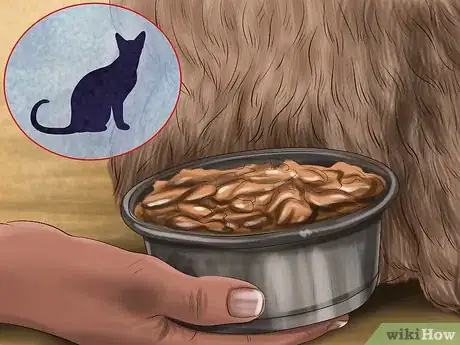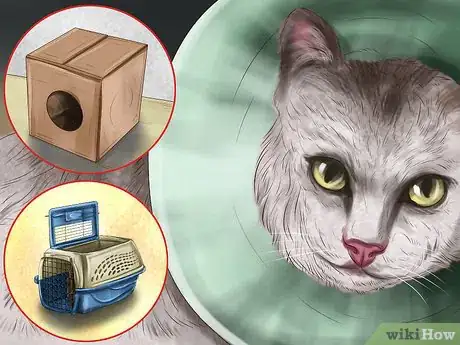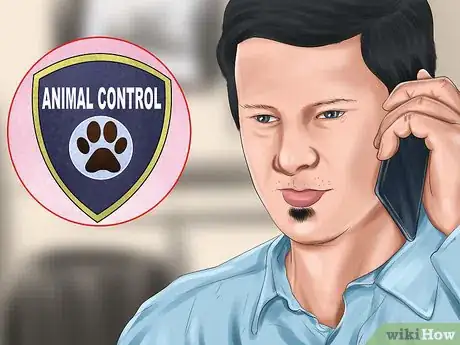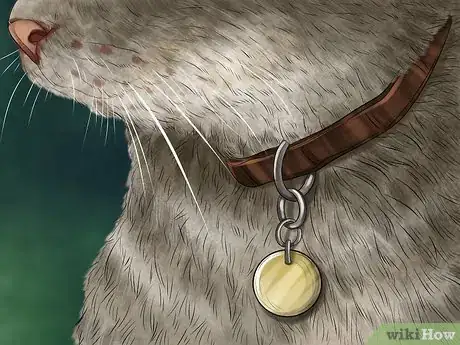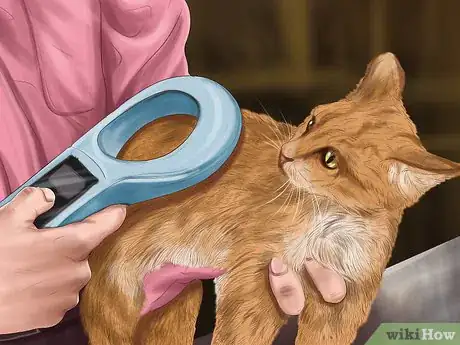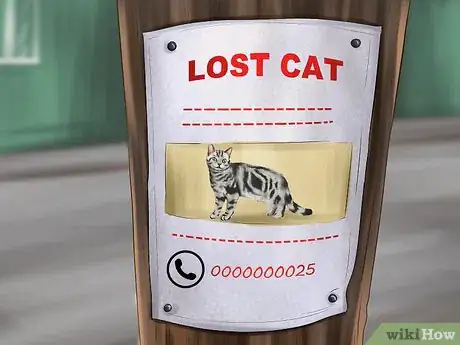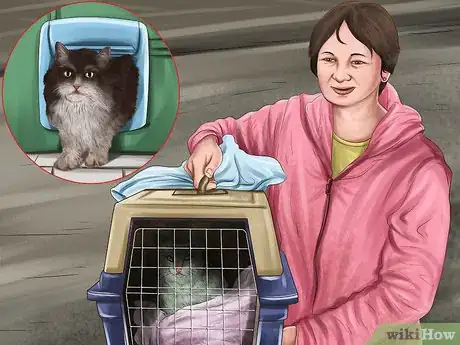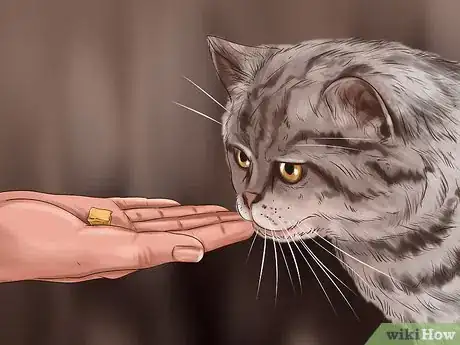This article was co-authored by Pippa Elliott, MRCVS. Dr. Elliott, BVMS, MRCVS is a veterinarian with over 30 years of experience in veterinary surgery and companion animal practice. She graduated from the University of Glasgow in 1987 with a degree in veterinary medicine and surgery. She has worked at the same animal clinic in her hometown for over 20 years.
This article has been viewed 64,130 times.
Have you ever seen a cat or small kitten running down the sidewalk all alone? A defenseless little animal that is lost or alone stirs up feelings of empathy and compassion, and you may find yourself wanting to help. By exercising care in capturing the animal, gathering all the appropriate information, and taking the right steps to get in touch with the owner, you can be immensely helpful in rescuing a lost kitten or cat.
Steps
Capturing the Animal With Care
-
1Look for signs that the cat is lost. It can be difficult to tell whether a cat is truly lost, or if it is allowed to venture outside its home. The cat may also be a stray with no home to return to. In general, if a cat seems healthy and calm, you may want to leave him alone. If they seem malnourished, injured, or afraid, they may be either a stray or a lost pet. If the cat is wearing a collar or tags, they definitely belong to someone. It never hurts to contact the owner.
-
2Approach slowly. The first step in rescuing a lost cat is to get it into your custody. In order to do this, you must first approach the cat slowly and with caution. You do not want to startle it, and you also don’t want to get hurt.[1]Advertisement
-
3Speak in a calm voice. As you approach the animal, speak to them in a calm soothing voice. Kittens and cats tend react well to calm words. You may also try clicking, meowing, or saying “here, kitty kitty.”[2]
-
4Use food to coax the animal to you. Using food to coax the animal toward you can be a safe and effective way to bring them close. Be sure to use food that a cat likes, such as canned cat food, tuna, cheese, or milk.[3]
-
5Confine the cat safely. Generally speaking, cats do not like to be held or restrained, so it is a good idea for stray cats to be confined somewhere safe. You can try placing the cat inside a pet carrier, a secure cardboard box (with air holes), a small room in your home, or, briefly, in your car, as long as your car is well ventilated and it the temperature isn’t too hot.[4]
-
6
Locating the Owner
-
1Check for ID tags. Once you have restrained the animal, the next step is to look for I.D. tags. If the cat it wearing a collar, look for tags attached to the collar, or information written directly on the collar. Read this information, and use it to contact the cat’s owner.[7]
-
2Have the cat scanned for a chip. If you do not see any I.D. tags, it is possible that the cat has been implanted with an I.D. chip. Visit your local animal shelter to have the cat scanned for an I.D. chip.[8]
-
3Check the laws in your state. If you are considering keeping this cat as your own (if the owner cannot be found), it is a good idea to check the pet ownership laws in your state. In most places, a stray animal is not “owned” by a finder until certain requirements are met.[9]
- Requirements may include keeping the cat in custody for a specific length of time, obtaining vaccinations, and obtaining a license.
- Contact your local animal control agency, SPCA, or humane society to determine the requirements in your state.
-
4Call local animal shelters. When a pet goes missing, the first thing most owners will do is contact animal shelters in the area. Make a list of any animal shelters near the place where you found the cat and call them. Either a cat fitting this description may have been reporting missing, or you can report the lost cat as found. This way, if the owner should call, the shelter will put them in touch with you.
-
5Look for existing fliers or ads for lost pets. If this cat has been missing for a few days (or more) there may be lost pet fliers or ads posted in your area. Look on local bulletin boards, as well as in the newspaper or on craigslist for ads fitting the description of the cat you’ve found.
-
6Post fliers. If you have not found fliers or ads looking for this cat, you may want to post some yourself. Take a picture of the cat and photocopy it onto a sheet of paper with a brief description of the animal, where you found it, and your contact information. You may also consider placing an ad in your local newspaper or on craigslist (both are usually free).[10]
-
7Take the cat to an animal shelter. If you do not want to keep the animal in your care, the best course of action is to drop them off at an animal shelter. This is actually the most effective way for lost pets to be reunited with their owners.[11]
-
8Ask yourself difficult questions. Whenever you begin helping a lost cat, you must ask yourself a few important questions. First, you must ask, “If I locate the owner, will I be willing to give this cat back to them?” Second, you must ask, “If I do not find the owner, am I willing to welcome this cat into my home?” If the answer to either one of these questions is “no,” then you should take the cat to your local animal shelter right away.[12]
Providing Temporary Care
-
1Provide a litter box. If you are going to take the cat into your home, even for a short period of time, you need to ensure that the cat stays healthy. An important first step is providing a litter box for the cat. Fill the box with litter, place it someplace quiet, and show the cat where the litter box is.
- You can purchase an inexpensive box and some littler at a pet store.
- Using something from your home, like a cardboard box, is likely to leak and cause a mess.
-
2Feed the cat. Cat food comes in many different types. Select a dry food appropriate for the cat (e.g., kitten food for a kitten or regular cat food for an adult). Offer dry food to the cat first, following serving size on the package. If the cat will not eat the dry food, you may try offering canned cat food.
-
3Provide fresh water. In addition to food, set out a dish for your cat with clean, fresh water. Just like you, the cat must drink water daily to survive. Be sure to refresh this dish with fresh water each day.
- Avoid offering the cat milk.
- Although many cats enjoy milk, it can actually cause digestive distress.
-
4Give the cat some space. Whenever you bring a new animal into your home, you need to give them some space and time to get comfortable. Choose a quiet room for the cat. Place their food, water, and any toys there, as well as someplace comfortable to relax. If you have other animals, it is a good idea to introduce them slowly.
-
5Visit your local vet. Especially if the cat is very young, or if they seem sick, you may consider bringing the cat to a veterinarian. A vet will be able to tell you the approximate age of the animal, and check for any serious injuries or illnesses. Before seeking medical treatment for a cat, be sure that you are prepared to take on that financial responsibility.[13]
-
6Play with the cat. Cats need plenty of activity and attention. You can play with a cat using household items (like a feather on a string) or store-bought cat toys. Playing with the cat will boost their mood and help them to stay healthy.
Warnings
- Do NOT attempt to handle a cat that looks like it may be feral. If it attempts to bite, walk away slowly. If it plunges for you, run away and get help immediately.⧼thumbs_response⧽
References
- ↑ http://www.americanhumane.org/animals/adoption-pet-care/caring-for-your-pet/if-you-find-a-lost-pet.html
- ↑ http://www.americanhumane.org/animals/adoption-pet-care/caring-for-your-pet/if-you-find-a-lost-pet.html
- ↑ http://www.americanhumane.org/animals/adoption-pet-care/caring-for-your-pet/if-you-find-a-lost-pet.html
- ↑ http://www.americanhumane.org/animals/adoption-pet-care/caring-for-your-pet/if-you-find-a-lost-pet.html
- ↑ http://www.americanhumane.org/animals/adoption-pet-care/caring-for-your-pet/if-you-find-a-lost-pet.html
- ↑ http://www.humanesociety.org/animals/resources/tips/what_to_do_stray_pet.html
- ↑ http://www.americanhumane.org/animals/adoption-pet-care/caring-for-your-pet/if-you-find-a-lost-pet.html
- ↑ http://www.americanhumane.org/animals/adoption-pet-care/caring-for-your-pet/if-you-find-a-lost-pet.html
- ↑ http://www.humanesociety.org/animals/resources/tips/what_to_do_stray_pet.html
- ↑ http://www.americanhumane.org/animals/adoption-pet-care/caring-for-your-pet/if-you-find-a-lost-pet.html
- ↑ http://www.americanhumane.org/animals/adoption-pet-care/caring-for-your-pet/if-you-find-a-lost-pet.html
- ↑ http://www.humanesociety.org/animals/resources/tips/what_to_do_stray_pet.html
- ↑ http://www.humanesociety.org/animals/resources/tips/what_to_do_stray_pet.html
About This Article
If you find a lost kitten, start by looking for I.D. tags so you can contact the owner. If the kitten seems injured or afraid, approach it slowly while speaking in a calm voice so you don’t startle it. You can also use food, such as tuna or milk, to get the cat to come close to you. If you can, place the kitten in a pet carrier or another secure area to keep it safe. Once it’s safely confined, call the phone number on the cat’s I.D. tag or bring it to an animal shelter where they can scan it for an I.D. chip. For tips from our Veterinary co-author on how to care for a lost kitten until you locate its owner, read on.



